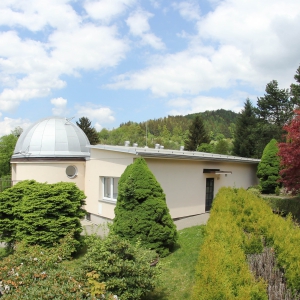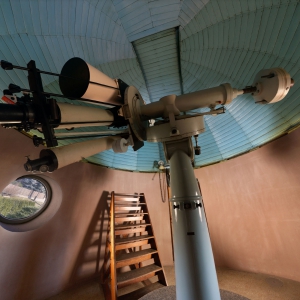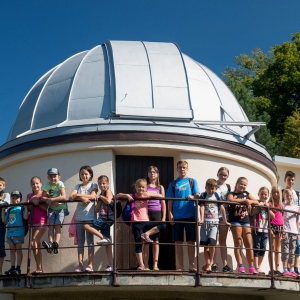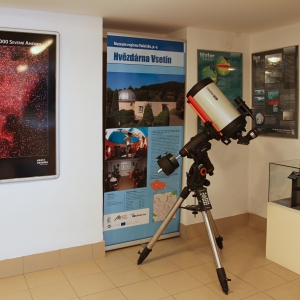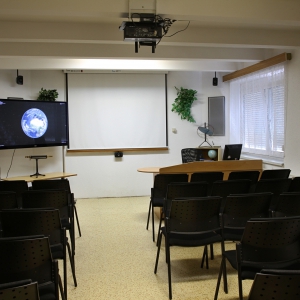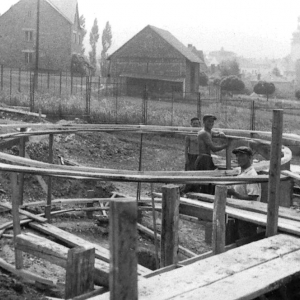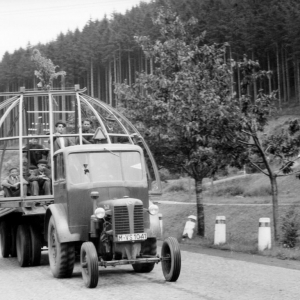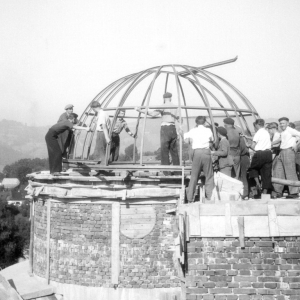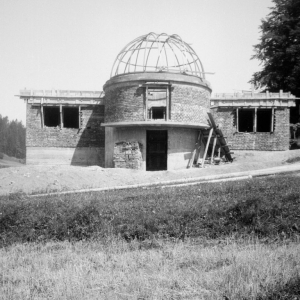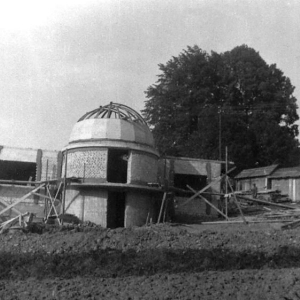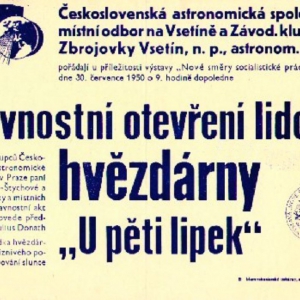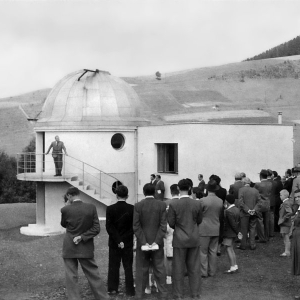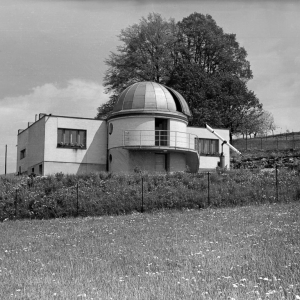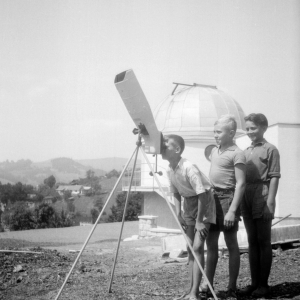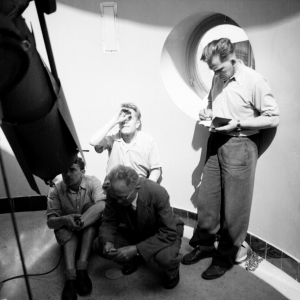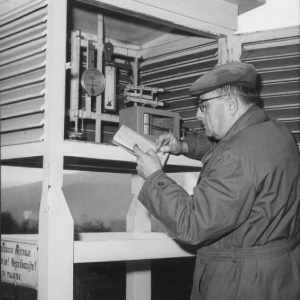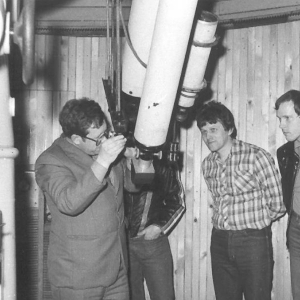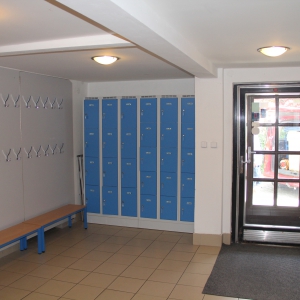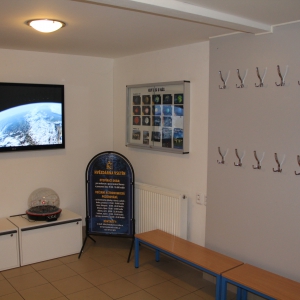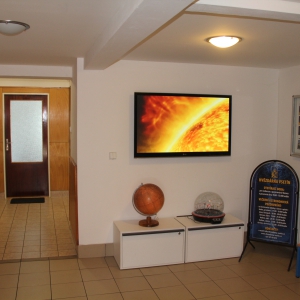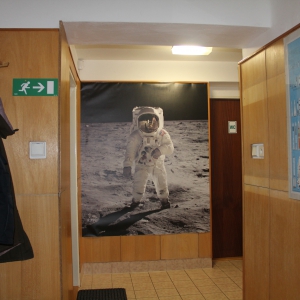The Vsetín observatory (Hvězdárna) is located near the Vsetín Castle on Jabloňová Street, which takes you from Horní náměstí to the cemetery. The observatory was founded in 1950 and since 2005 it has been operating as a part of the Muzeum of Moravian Wallachia Region. The observatory does educational programmes about natural sciences for the public. The programmes present astronomy, space travel and related topics to children and adults, who can view the sky at night and during the day or take part in lectures and discussions. The observatory believes in an informal approach to the public and the staff strive to make astronomy, meteorology and other scientific research fun for the whole family. For more information about our observatory, click HERE
In 1948, soon after the end of the World War II, several local enthusiasts interested in astronomy worked with the government to established a branch of the Czechoslovak Astronomical Society in Vsetín. They managed to push through their idea of an observatory as a part of the preparations of the exhibition "Wallachians at Work". The construction project, funded in large part by Zbrojovka Vsetín weapon factory, was approved by local and regional authorities. The next phase of the project, the construction itself, went quite quickly and by the end of 1949, the building shells of an observatory, a lecture hall and a clubhouse and office were built.
All the remaining finish work was carried out by a great number of volunteers. When the dome of the observatory with all its control mechanisms was mounted, the building was open to the public. The opening ceremony was held on July 30, 1950.
There was a lot of interest in astronomy among the local people and soon the observatory was too small. In the period 1952-1956, the facility was expanded and between 1961 and 1965 they added another building for independent workshops below the main observatory. This new building housed an electrotechnical shop, a mechanical garage, a spectral laboratory and a boiler room. In 1970, a warehouse and a joiner shop were constructed. Landscaping around the facility and other smaller construction jobs were carried out continuously throughout these three decades.
The first astronomical telescope was a reflector made by the director of the observatory at the time, Oldřich Křenek. He designed a high-quality mirror telescope with a lens of 200 mm in diameter. In 1957, this telescope was replaced with three new lens telescopes placed on an equatorial mount. The diameter of the lens in the largest refractor was 200 mm and its focal length was 3 meters.
Then in 1961, the original optical elements in the refractors were substituted by high-quality lenses by Carl Zeiss Jena. The equatorial mount was replaced in 1964. However, these telescopes and the mounting from the early 1960s have been in use ever since. For the purposes of scientific observation, a new telescope with a Newton-type reflector with a mirror lens with a diameter of 300 mm and a focal length of 1700 mm was installed on July 14, 2008.
Individuals
|
Adults
|
Children age 6-15, students, seniorsi, people with disabilities
|
Family ticket: 1 or 2 adults with 1-3 children
|
|
50 Kč
|
40 Kč
|
120 Kč
|
| |
|
|
Groups
|
Groups of children age 6 and up (elementary schools, secondary schools, clubs, children’s homes, children’s centers, camps)
|
Groups of children younger than 6 (kindergartens, family centres) and groups of people with disabilities
|
|
50 Kč /person
|
40 Kč /person
|
Mobile planetarium
|
Short Projection (30 min)
|
Long Projection (40 min)
|
|
50 Kč /person
|
60 Kč /person
|
Premises for Rent
|
Groups of children or adults
|
|
|
300 Kč /hr.
|
Observatory terrace and garden, small or big lecture hall
|
Hvězdárna Vsetín Pricelist
Small and big lecture halls, garden area
- the halls are 29 a 33 square meters large, seating 20 and 30 respectively
- the observatory and the gardens are suitable for corporate presentations on informal gatherings
- the wifi, a data projector, a TV and a kitchen are all available indoors
- you have access to a cloakroom and a bathroom as a part of your rental
- the outdoor area features a fireplace with seating and space for games or competitions
- in addition to your rental, you can negotiate a tour of the observatory and the weather station or sky viewing if weather permits
- the shortest rent period is 3 hours indoors and 2 hours outdoors
PRICE 300 Kč/hr (during regular opening hours: Mon - Fri 9:00 - 15:00)
PRICE 400 Kč/hr (outside regular opening hours)
Additional Services
- price does not include additional services, these are subject to agreement
- setup and use of data projector can be provided for extra charge 200 Kč/hr
The rent price includes cleaning services
If you are interested in renting space at the observatory, please contact us and we will be happy to show you around. We will do our best to meet your needs.
Opening Hours
We open at 9:00 tomorrow
Astronomical observations for the public take place at the Vsetín Observatory in the evening under cloudless skies, on Fridays in the hours below.
January, December 17: 00–19: 00
February, November 18: 00–20: 00
March, October 19: 00–21: 00
April, September 20: 30–22: 30
May, August 21: 00–23: 00
June, July 22: 00–23: 30
| Monday |
09:00 – 15:00 |
| Tuesday |
09:00 – 15:00 |
| Wednesday |
09:00 – 15:00 |
| Thursday |
09:00 – 15:00 |
| Friday |
09:00 – 15:00
We apologize, but due to operational reasons the evening observation will NOT take place this Friday. |
| Saturday |
Closed |
| Sunday
|
Closed |
Click and Control the Map.
Co lze pozorovat v prosinci 2025
Večerní astronomická pozorování se v prosinci konají jen v pátky 5.12. a 19.12., vždy od 17:00 do 19:00 hodin.
Pozorování probíhají pouze za jasné a bezmračné oblohy!
Vstupné: děti 6 až 15 let / studenti / senioři / ZTP 40 Kč, dospělí 50 Kč, rodinné (do 5 osob) 120 Kč.
Pro zájemce, kteří chtějí sami sledovat noční oblohu připravuje server HEAVENS ABOVE interaktivní mapu hvězdné oblohy. Ovládání je velmi jednoduché, v horní části je možno změnit datum a čas, pro který se má vygenerovat mapa, v dolní části pak co vše má být na mapě zobrazeno. Mapu si můžete pomocí ikony tiskárny přenést do formátu pdf a pohodlně vytisknout pro potřeby pozorování.
Všechny časové údaje uvedené v textu jsou v SEČ.
Slunce
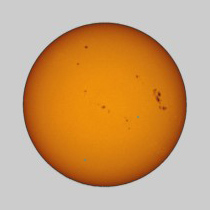 |
Dne 1. prosince vychází Slunce v 7 hodin 37 minut a zapadá v 16 hodin 01 minutu, dne 31. prosince vychází v 7 hodin 59 minut a zapadá v 16 hodin 08 minut.
V neděli 21. prosince v 16 hodin 03 minuty vstoupí Slunce do znamení Kozoroha. Nastává zimní slunovrat a z astronomického hlediska začíná zima.
|
Měsíc
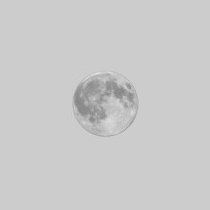 |
Večer bude Měsíc nejlépe pozorovatelný až v samém závěru prosince.
Fáze Měsíce
| Fáze |
Datum |
| úplněk |
5. prosince v 00 hodin 13 minut |
| poslední čtvrt |
11. prosince ve 21 hodin 51 minut |
| nov |
20. prosince ve 02 hodiny 43 minuty |
| první čtvrt |
27. prosince ve 20 hodin 09 minut |
Ve čtvrtek 4. prosince ve 12 hodin se Měsíc na své dráze Zemi nejvíce přiblíží (356 967 km), bude v přízemí čili perigeu. Naopak, ve středu 17. prosince v 07 hodin se od Země nejvíce vzdálí (406 301 km), bude tedy v odzemí – apogeu.
|
Merkur
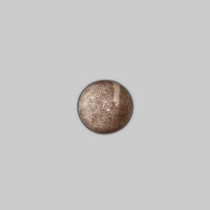 |
Nejmenší planetu Sluneční soustavy můžeme spatřit v první polovině měsíce ráno nízko nad jihovýchodním obzorem. V té době bude její jasnost rychle narůstat z +0,1 mag na -0,5 mag. |
Venuše
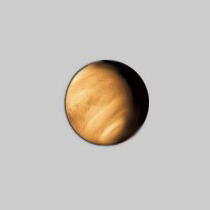 |
Planeta není v prosinci pozorovatelná. |
Mars
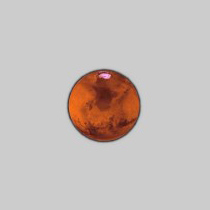 |
Rudá planeta není tento měsíc pozorovatelná. |
Jupiter
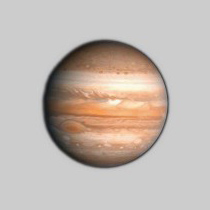 |
Královskou planetu můžeme pozorovat téměř po celou noc mimo večera v souhvězdí Blíženců. Její jasnost bude pomalu narůstat z -2,4 mag na -2,6 mag. |
Saturn
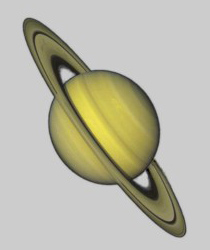 |
Pána prstenců můžeme spatřit v první polovině noci. Nadále zůstává v souhvězdí Vodnáře a jeho jasnost nepatrně poklesne z +1,1 mag na +1,2 mag. |
Uran
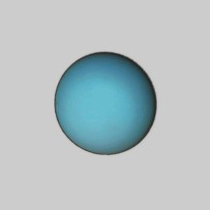 |
Uran se po většinu roku 2025 bude pohybovat souhvězdím Býka, kam se na počátku března přesune z Berana. V lednu bude pozorovatelný v první polovině noci, s přibývajícím časem se ale bude jeho viditelnost postupně zkracovat směrem k večeru a jeho jasnost přitom nepatrně poklesne z +5,6 mag na +5,8 mag. Od konce dubna pak již nebude pozorovatelný vůbec.
Na oblohu, nejprve jen ranní, se Uran vrátí v červenci. Nalezneme jej ráno nad východním obzorem jižně od známé hvězdokupy M45 Plejády, a severně od Venuše. Uran se bude během léta a podzimu účastnit pravidelných setkání s Měsícem, Plejádami a Aldebaranem.
Období jeho nejlepší viditelnosti nastává od srpna až do konce roku, kdy bude na obloze nad naším obzorem po celou noc či po většinu noci a jeho jasnost se do konce roku vrátí na +5,6 mag.
Uran lze (alespoň teoreticky) pozorovat i pouhým okem. Rozhodně vhodnější je však použít k jeho vyhledání mezi hvězdami dalekohled. |
Neptun
 |
Po celý rok 2025 se bude Neptun nacházet v souhvězdí Ryb poblíž hranice s Vodnářem. K vyhledání planety je potřeba použít alespoň triedr nebo malý astronomický dalekohled. Kotouček planety lze rozlišit až při zvětšení 200krát či větším. Vodítkem pro nalezení může být planeta Saturn, která bude na obloze v blízkosti Neptunu po celý rok.
Počátkem roku bude Neptun na nebi večer, postupně ale bude klesat k jihozápadu a v březnu se planeta stane nepozorovatelnou. Na oblohu se vrátí v červnu. Nejlepší podmínky na pozorování budou od konce července do poloviny října, kdy planeta bude nad horizontem po většinu noci nebo po celou noc.
Jasnost Neptunu se bude v průběhu roku měnit mezi +7,8 mag a +8,0 mag. |
Trpasličí planety
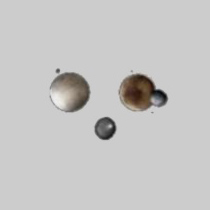 |
V současnosti patří do skupiny trpasličích planet pět těles: největší těleso hlavního pásu asteroidů mezi Marsem a Jupiterem – (1) Ceres, a čtyři velká transneptunická tělesa – (134 340) Pluto, (136 108) Haumea, (136 199) Eris a (136 472) Makemake.
Amatérskými prostředky je rozumně pozorovatelná pouze Ceres. Až do začátku srpna však nebude tato trpasličí planeta pozorovatelná. Pak ji s jasností +8,6 mag nalezneme na ranní obloze v souhvězdí Velryby. Nejlepší podmínky pro pozorování nastanou začátkem října, kdy bude dosahovat jasnosti +7,6 mag a vrcholí ve výšce téměř 30° nad obzorem. Stále se bude pohybovat souhvězdním Velryby, v němž setrvá až do konce roku 2025.
Pluto, Haumea, Eris a Makemake jsou tělesa natolik vzdálená, že jsou ze Země pozorovatelná pouze velkými teleskopy. Pluto má totiž jasnost +14,5 mag, Makemake s Haumeou +17 mag a Eris dokonce jen +19 mag! |
Meteory
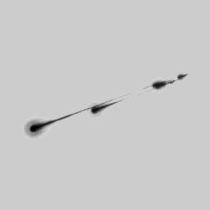 |
Prosincovou oblohu již tradičně ozdobí meteorický roj Geminid. Jedná se o jeden z nejaktivnějších rojů v roce. Pro pozorování roje budou letos relativně příznivé podmínky, protože v době jeho maxima (14. prosince) bude Měsíc tři dny po poslední čtvrti. |
Komety
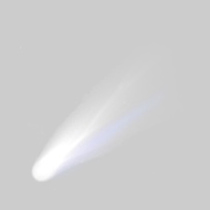 |
Tento měsíc nebude pozorovatelná žádná jasná kometa. |
Zdroj informací: Hvězdářská ročenka 2025, Stellarium, internet
Portable planetarium
Our digital mobile planetarium offers interesting audiovisual experiences, so it helps to make your lessons attractive and fun. In essence, It promotes and supports education, especially in the field of astronomy. It is a didactic aid that will come to you wherever you are.
The planetarium consists of an inflatable hemisphere with a projection screen on the inside. A small fan creates overpressure, which keeps the hemisphere inflated in a dome shape. Finally, there is a computer-controlled projection device with a 360 ° lens that shows an artificial sky on the inside of the dome.
During a screening, the audience lie down or sit on mats and pillows. The image above and around them gives a realistic impression of being outdoors at night and looking at a real sky. If you project a film, the audience is drawn straight into the action and feel like they are a part of it. Watching a film in the dome is an exciting and unusual experience for children and adults alike.
The capacity of our mobile planetarium is 25 people or up to 30 small children. If you book it for your school, it is a good idea to schedule several screenings one after another to fit more classes.
The planetarium can be used in other than school settings, however. It is an interesting space for public events of cultural or educational nature. You can also rent it corporate events or for private events, along with our services.
If you do plan to visit our planetarium, we have a few recommendations for you:
The planetarium cannot really be used outdoors. It needs to be set up in gyms, auditoriums, dining rooms and halls with open space with dimensions at least 7 × 8 meters and with the ceiling height of 4 meters. It also requires power supply with 230 V. It takes time 45-60 minutes to set up and 30-45 minutes to break down. In addition you need to allow 15-20 minutes between screenings to renew the air inside the dome.

Planetarium Programmes

